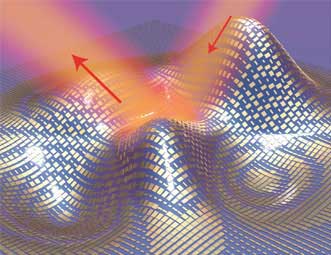
Metamaterial 'Skin Cloak' Makes Microscale Object Invisible
An ultrathin metasurface that has been used to hide microscopic objects could be scaled up to provide visible-light cloaking of macroscale objects, according to its developers at the University of California.
The researchers fashioned a "skin cloak" about 80 nm thick consisting of brick-like blocks of gold nanoantennas that redirect light. The cloak can be turned on or off simply by switching the polarization of the nanoantennas.
"This is the first time a 3D object of arbitrary shape has been cloaked from visible light," said Xiang Zhang, a professor at UC Berkeley and director of the Materials Sciences Division at Lawrence Berkeley National Laboratory.
Earlier metamaterial cloaks developed in Zhang's lab were bulky and hard to scale up, and created a phase difference between the cloaked region and the surrounding background that made the cloak itself detectable.
"Creating a carpet cloak that works in air was so difficult we had to embed it in a dielectric prism that introduced an additional phase in the reflected light, which made the cloak visible by phase-sensitive detection," said Xingjie Ni, a former member the Zhang group who is now an assistant professor at Pennsylvania State University.
"Recent developments in metasurfaces, however, allow us to manipulate the phase of a propagating wave directly through the use of subwavelength-sized elements that locally tailor the electromagnetic response at the nanoscale, a response that is accompanied by dramatic light confinement."

An illustration of a metasurface skin cloak made from an ultrathin layer of nanoantennas (gold blocks) covering an arbitrarily shaped object. Light reflects off the cloak (red arrows) as if it were reflecting off a flat mirror. Courtesy of the Xiang Zhang group, Berkeley Lab/UC Berkeley.
The new skin cloak was used to mask an arbitrarily shaped 3D sample object about 1300 μm2 in area. In the experiment, red (730-nm) light reflected off the surface of the skin cloak in a manner identical to light reflecting off a flat mirror, making the object underneath it invisible, even to phase-sensitive detection.
"A phase shift provided by each individual nanoantenna fully restores both the wavefront and the phase of the scattered light so that the object remains perfectly hidden," said doctoral student Zi Jing Wong.
Invisibility skin cloaks on the microscopic scale might prove valuable for hiding the detailed layout of microelectronic components or for security encryption purposes, the researchers said. At the macroscale, among other applications, invisibility cloaks could prove useful for 3D displays.
Funding for the project came from the U.S. Department of Energy's Office of Science.
The research was published in Science (doi: 10.1126/science.aac9411).
Published: September 2015